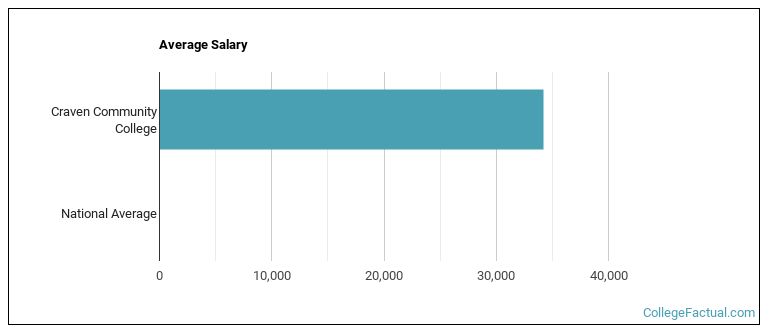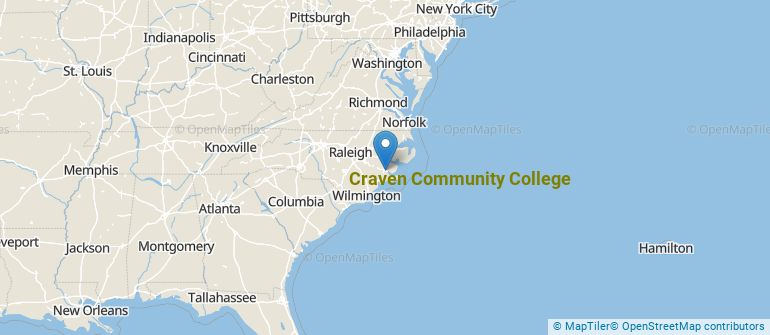 by our College Data Analytics Team
by our College Data Analytics TeamExplore the best ranked schools for the programs you are most interested in.
According to College Factual's 2025 analysis, Craven Community College is ranked #1,355 out of 2,152 schools in the nation that were analyzed for overall quality. This is an improvement over the previous year, when Craven Community College held the #1,729 spot on the Best Overall Colleges list.
Craven Community College also holds the #40 spot on the Best Colleges in North Carolina ranking.
If you are worried about getting into Craven Community College, don't be. The school has a liberal open admissions policy, which means you only need to meet basic requirements in order to be admitted. Still, be sure to submit a complete application and provide any other requested materials.
At Craven Community College, the student to faculty ratio is an excellent 12 to 1. That's much better than the national average of 15 to 1. This indicates that many classes will probably be small, and students will have ample opportunites to work closely with their professors and classmates.
In addition to the student to faculty ratio, some people look at what percentage of faculty members are full-time as a sign of how much time professors will be able to spend with their students. This is because part-time teachers may not be be on campus as much as their full-time counterparts.
The full-time faculty percentage at Craven Community College is 26%. This is lower than the national average of 47%.
The freshmen retention rate is a sign of how many full-time students like a college or university well enough to come back for their sophomore year. At Craven Community College this rate is 62%, which is a bit lower than the national average of 68%.
During the 2017-2018 academic year, there were 2,629 undergraduates at Craven Community College with 726 being full-time and 1,903 being part-time.
The net price is calculated by adding tuition, room, board and other costs and subtracting financial aid.Note that the net price is typically less than the published for a school. For more information on the sticker price of Craven Community College, see our tuition and fees and room and board pages.
The student loan default rate at Craven Community College is 1.0%. This is significantly lower than the national default rate of 10.1%, which is a good sign that you'll be able to pay back your student loans.

See which majors at Craven Community College make the most money.
Get more details about the location of Craven Community College.

Contact details for Craven Community College are given below.
| Contact Details | |
|---|---|
| Address: | 800 College Ct, New Bern, NC 28562-4900 |
| Phone: | 252-638-7200 |
| Website: | https://cravencc.edu/ |
| Most Popular Majors | Bachelor’s Degrees | Average Salary of Graduates |
|---|---|---|
| Accounting | 444 | NA |
| Liberal Arts General Studies | 444 | NA |
| Computer Information Systems | 155 | NA |
| Precision Metal Working | 88 | NA |
| Vehicle Maintenance & Repair | 67 | NA |
| Nursing | 60 | NA |
| Electronics Engineering Technology | 56 | NA |
| Health & Medical Administrative Services | 46 | NA |
| Teacher Education Grade Specific | 44 | NA |
| Allied Health & Medical Assisting Services | 42 | NA |
Online learning options are becoming more and more popular at American colleges and universities. Online classes are great for students who have busy schedules or for those who just want to study on their own time.
In 2022-2023, 2,077 students took at least one online class at Craven Community College. This is an increase from the 1,993 students who took online classes the previous year.
| Year | Took at Least One Online Class | Took All Classes Online |
|---|---|---|
| 2022-2023 | 2,077 | 1,216 |
| 2021-2022 | 1,993 | 1,203 |
| 2020-2021 | 2,172 | 1,375 |
| 2018-2019 | 2,368 | 1,108 |
Learn more about online learning at Craven Community College.
Footnotes
*The racial-ethnic minorities count is calculated by taking the total number of students and subtracting white students, international students, and students whose race/ethnicity was unknown. This number is then divided by the total number of students at the school to obtain the racial-ethnic minorities percentage.
References
More about our data sources and methodologies.